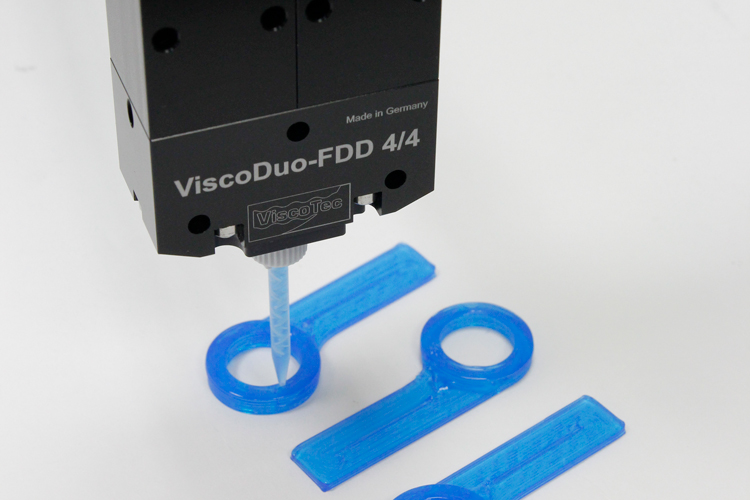ViscoTec’s Latest Two-Component Printhead 3D Prints Polyurethanes, Silicone and Epoxies With More Precision
Germany company ViscoTec makes systems that are required for conveying, dosing, applying, filling, and emptying medium to high-viscosity fluids. Based in Bavaria with subsidiaries in China, India, Singapore, and the US, ViscoTec first began working with 3D printing several years ago when it introduced a paste extruder, followed by its Fluid Dosing and Deposition (FDD) Starter Kit.
In 2017, the award-winning company launched the first of its innovative printheads, followed the next year by its vipro-HEAD with optional heating function for viscous fluids, and then the vipro-HEAD 3/3 and 5/5 for 3D printing two-component viscous fluids and pastes. Now ViscoTec is launching its latest two-component vipro-HEAD, which allows both of its motors to be directly controlled through a 3D printer – making it easy to precisely mix and print two-component viscous fluids and pastes.
Two-component 3D printing is a big deal, because it can really expand the scope of possible 3D printing applications. For instance, silicone can be 3D printed in this way, which makes it possible to be used in the medical field and for fabricating things like shoe soles. But the latest version of the vipro-HEAD is even more advanced, not just because of its two-component 3D printing ability, but because it’s supported by pressure sensors for more efficient and reliable printing.
The printhead’s main components are the rotor and stator, which make sure that the two components continuously and uniformly deliver material from the suction point all the way to the outlet, no matter how small the quantity and layer height. This volumetric conveying principle means that the vipro-HEAD can guarantee, as the company puts it, “linearity of volume and speed.” Regardless of their overall viscosity, liquids and pastes can be processed through the two-component printhead, making it the perfect choice for materials like acrylates, polyurethanes, silicone, and epoxy or polyester resins.
 Each of the two material components can be fed individually, in the exact dosage, into the static mixer through a flow-optimized channel. Customers can choose a specific static mixer, which can be attached to the printhead, based on their materials and the degree to which they need to be mixed together.
Each of the two material components can be fed individually, in the exact dosage, into the static mixer through a flow-optimized channel. Customers can choose a specific static mixer, which can be attached to the printhead, based on their materials and the degree to which they need to be mixed together.
High-quality sensors are used to guarantee quality prints by monitoring outlet pressures of each component, which is obviously extremely important when it comes to the repeatable part quality that’s necessary in series production. These sensors, along with the vipro-HEAD’s use of separately controllable drives, are major improvements, in addition to an optional venting screw, which allows excess air to vent quickly. The sensors, which come with detachable 5 m long motor cables, also help in avoiding quality differences or process delays that come from hardened mixers, which helps protect both the stator and the rotor from being damaged.
Because both components enter the stator through a separate inlet, and the materials can be individually dosed, the vipro-HEAD can achieve high-quality, reliable 3D printing of liquid two-part components that have excellent chemical resistance and mechanical properties. In addition, ViscoTec’s pressure-tight, self-sealing displacement system is used in both sizes of the vipro-HEAD, ensures controlled rotary movement of the rotor, which conveys the components through displacement in the stator. This means that the material is returned through reversing the rotation direction, which ensures high quality and a controlled material thread break.
Because the new vipro-HEAD can help 3D print components that are able to withstand chemical and mechanical stresses, ViscoTec can provide companies in the aerospace, automotive, electronics, and medical fields with an optimal solution for two-component 3D printing of viscous fluids and pastes.
What do you think about this? Discuss this story and other 3D printing topics at 3DPrintBoard.com or share your thoughts in the Facebook comments below.
[Images: ViscoTec]
Subscribe to Our Email Newsletter
Stay up-to-date on all the latest news from the 3D printing industry and receive information and offers from third party vendors.
You May Also Like
3D Printing Unpeeled: New Arkema Material for HP, Saddle and Macro MEMS
A new Arkema material for MJF is said to reduce costs per part by up to 25% and have an 85% reusability ratio. HP 3D HR PA 12 S has been...
3D Printing News Briefs, January 20, 2024: FDM, LPBF, Underwater 3D Printer, Racing, & More
We’re starting off with a process certification in today’s 3D Printing News Briefs, and then moving on to research about solute trapping, laser powder bed fusion, and then moving on...
3D Printing Webinar and Event Roundup: December 3, 2023
We’ve got plenty of events and webinars coming up for you this week! Quickparts is having a Manufacturing Roadshow, America Makes is holding a Member Town Hall, Stratafest makes two...
Formnext 2023 Day Three: Slam Dunk
I’m high—high on trade show. I’ve met numerous new faces and reconnected with old friends, creating an absolutely wonderful atmosphere. The excitement is palpable over several emerging developments. The high...

































